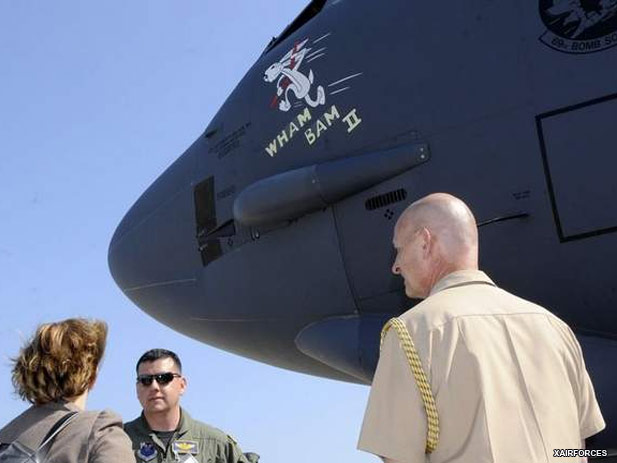
Global Strike B-52 flies historic mission

Talking with crew members and computers in a B-52 may soon be much easier. Boeing, which built all 744 B-52s between 1952 and 1962, competitively provides upgrades for the fleet, and this week announced a communications suite upgrade that will bring the giant airplane into the 21st century.
Monday, Boeing announced the successful Aug. 3 evaluation flight of a B-52 modified with the Combat Network Communications Technology (CONECT) interphone system. The interphone system enables crew members to communicate with one another, other aircraft and with units and controllers on the ground. The upgrade will eventually be added to all the B-52s now flying.
B-52 flight and ground crew members from Minot, Barksdale's sister bomber base in North Dakota, wrote a new chapter in the history of Air Force Global Strike Command with a recent goodwill visit to Russia.
Their bomber, "Wham Bam II," flew a route rarely used by aircraft, over the North Pole and the polar ice cap. It returned from its 10-day mission to take part in the MAKS 2011 International Aviation and Space Salon on Tuesday by way of an Air Force Base in Alaska.
"The flight over the pole was quite unusual — we had never done it before," said Maj. Patrick Small, an instructor-navigator and the senior ranking officer on the flight. "(There were) a lot of weather and global effects to take into account flying over the top of the world, the most important being the location, wind, freezing temperatures as well as other things, such as time changes. We didn't know what kind of effects flying over the magnetic North Pole would have on navigation systems. But the flight was uneventful and went as planned."
The flight continues a post-Cold War precedent started by Barksdale in 1992. In then-unprecedented gestures of friendship, a pair of Barksdale B-52s and a KC-10 tanker visited Russia, followed by a visit to Barksdale by Russian Tu-95 Bear bombers and a support airplane two months later.
Air Force B-52s, including some from Barksdale, participated in 2003 and 2005 Moscow air shows/salons.
There's an even older tradition of flights to Russia. In early 1944, U.S. B-17 bombers started to fly shuttle missions to and from Italy and the former Soviet Union to harass German forces on the Eastern Front. That continued until German airplanes followed the Allied bombers to their base in Russia and destroyed many aircraft on the ground.
In addition to the B-52, the International Aviation and Space Salon featured the P-3C Orion, A-10 Thunderbolt II, F-16C Fighting Falcon, C-130J Super Hercules, C-5 Galaxy, F-15E Strike Eagle and KC-10 Extender aircraft. According to initial releases, there were about 100 air crew and support personnel from stateside and U.S. bases in Europe providing static displays and aerial flight demonstrations.
The crew made a first try to talk to stateside media Tuesday morning while flying home over the ice cap but found the going difficult, even with a Motorola Iridium satellite phone.
"Flying over the magnetic North Pole" can be difficult Small said. "There's holes in voice satellite coverage, and high frequency radio coverage is limited. Just being able to stay in touch with leadership is quite difficult."
The routing eliminated the need for in-flight refueling.
"We were able to save a few hours of flight time, for lack of better term 'taking a short cut' over the North Pole," Small said.
For the airmen, being on the ground in Russia was almost as exciting as the trip over. Visitors were "everybody from young kids just excited to see an airplane in general all the way up to retired Soviet military leaders who had heard about the B-52 their entire life but had never actually seen one," Small said.
"The Russians were really impressed with the age of the aircraft and what great shape (it) was in," said Capt. Tim Brown, the aircraft commander. B-52s now flying were built between 1960 and 1962 and are estimated to last until the year 2040.
"We told them how long we plan to fly the B-52. and they were just amazed," he said. "The other thing they were impressed with was the age of the crew and how much responsibility we take on at a young age. The Russians don't get that type of responsibility until they are much older."
There were technical complications, however, Capt. Clayton McCart said.
"They use the metric system," he said, noting the U.S. airplane measured its altitude in feet and that their altimeters are calibrated using a different protocol than that used by U.S. airplanes.
"That was something the crew had to look at thoroughly before we got there, and it was obviously a safety factor," he said.
"There's a lot of planning that goes into this," AFGSC spokesman Lt. Col. John Anderson said, noting that diplomatic issues had to be covered, as well as route clearances and physical and logistical considerations. "We actually had to have a B-52 towbar positioned there prior to the B-52 landing so it could be towed into place. ... A lot of people think it's just 'flying it over there,' but it takes a lot to get any type of military aircraft, especially a U.S. aircraft, into Russian airspace."
The augmented crew included three pilots, three navigators, a defensive systems operator and two crew chiefs responsible for keeping the 51-year-old airplane in tip-top shape.
Source: Written by John Andrew Prime - 16.08.2011 (www.shreveporttimes.com)
Photo: Capt. Patrick Small, a navigator in the 69th Bomb Squadron at Minot Air Force Base, N.D., greets Shelia Gwaltney (left), the deputy chief of mission for the U.S. Embassy in Moscow, and Rear Adm. Douglas Venlet, the U.S. Embassy defense attache, before giving them a tour of the B-52 Stratofortress "Wham Bam II" on Aug. 16, on display at MAKS, the Moscow International Aviation and Space Salon. / Special to The Times
(3.09.2011)
|